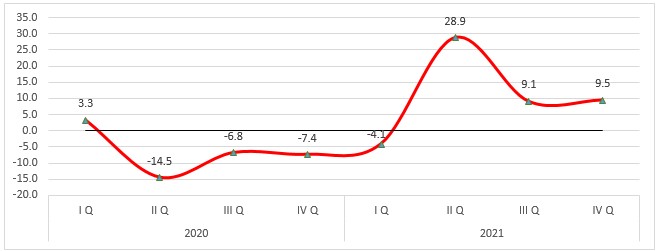Irakli Kobakhidze: “The government ensured a 10.6% economic growth rate when January and February were in a minus. This means that we overcame the situation that the pandemic brought us into and we even surpassed the pre-pandemic period.”
Verdict: FactCheck leaves Irakli Kobakhidze’s statement WITHOUT A VERDICT.
Resume:
The authorities have been frequently referring to the double-digit economic growth rate. However, a high economic growth rate is largely attributable to the base effect which is often referred to in Georgia’s political or expert community as the “spring effect.” In terms of the accuracy of the statement, it is important that Irakli Kobakhidze clarified that the high economic growth rate was linked with the recovery from the difficult situation of 2020. The 10.6% economic growth rate in 2021 means a 3% economic growth as compared to 2019. Certainly, economic recovery is a positive occurrence; nevertheless, the growth is small and Georgia’s success is relatively little with a 3% economic growth rate as compared to other countries.
In his statement, Irakli Kobakhidze links the 6.8% economic decline in 2020 exclusively with the pandemic and disregards the role of the government’s policy whilst he claims that the government should take a full credit for the 10.6% economic growth rate in 2021. In fact, the economic growth dynamic in both of these years is strongly linked with the government’s decisions. On the one hand, the 6.8% economic decline in 2020 is something for which the government “should take credit” and the “high” economic growth of 2021, given the base effect, is a technical figure resulting from the previous economic decline. In other words, both the sharp decline and the growth of the economy in 2020-2021 is a result of the inconsistent management of the pandemic whilst the real economic growth is merely 3% as compared to 2019 which is not an exemplary success when looking at the rest of the world.
Therefore, Irakli Kobakhidze’s statement that there was a sharp economic downturn in 2020 whilst today, notwithstanding a high economic growth, reality is far from being desirable, is more or less an accurate description of the reality but it lacks a broader context. However, this context which is absent in this statement, is largely evaluative in nature and without it is impossible to give verdict to his statement. Therefore, FactCheck confines itself by analysis of the statement alone and leaves Irakli Kobakhidze’s statement WITHOUT A VERDICT.
Analysis
Irakli Kobakhidze, Chairman of the Georgian Dream, commented on the dynamics of economic growth: (12:20) „The government ensured a 10.6% economic growth rate when January and February were in a minus. This means that we overcame the situation that the pandemic brought us into and we even surpassed the pre-pandemic period.”
According to the preliminary estimates of the National Statistics Office of Georgia, the real gross domestic product (GDP) growth in 2021 was 9.6% as compared to the same period of 2021 whilst the annual real growth of 2021 was 10.6%. As reported by the National Statistics Office of Georgia, the final statistical figures for 2021 will be published on 21 March 2022.
Recently, the authorities have been making frequent references to the double-digit economic growth figures. However, the higher economic growth rate is largely stipulated by the base effect since unprecedentedly stringent pandemic-related measures were imposed in March-June 2020 which basically paralysed many economic fields. The higher growth figures are registered vis-à-vis those periods. In 2020, the real economy contracted by 6.8% which resulted in a higher economic growth figure in light of lifting restrictions in 2021 and the restoration of a slackened total demand. This effect, occurring in 2021, is often referred to in Georgia’s political or expert community as the “spring effect.” This brings the part of Irakli Kobakhidze’s statement where claims that the government should take credit for economic growth figures partially under question.
According to Mr Kobakhidze’s statement, the 10.6% economic growth rate in 2021 means economic recovery as compared to 2019 which is a positive occurrence. However, the growth is small as compared to 2019 and only constitutes 3% and, therefore, Georgia’s economic recovery dynamic is not really impressive as compared to other countries. The economic decrease in January-February of 2021, to which Irakli Kobakhidze was referring, should also be partly explained by the base effect because pandemic-related restrictions were not introduced in the country in the first two months of 2020. The first confirmed coronavirus case in Georgia was reported on 26 February 2020.
Graph 1: Real GDP Growth Quarterly Dynamic (As compared to the same period of the previous year), %

Source: National Statistics Office of Georgia
The high economic growth rate is not a result of the government’s right policy but, instead, is technical growth caused in part by the inconsistent pandemic-related policy. In particular, at the very beginning the government used unprecedentedly stringent measures – important questions have been raised as to how evident-based and reasonable these measures were – and lifted most of the restrictions when the pandemic situation had worsened. As a result, the economy declined “excessively” in the first year whilst recovery in economic activity in light of lifting restrictions resulted in a technically high figure of economic growth. The acceleration of the economic growth rate is partially related to the inconsistent lifting of restrictions which made Georgia a leader in terms of most coronavirus deaths per 100,000 people.








